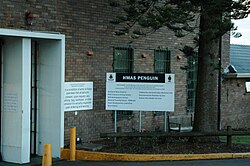This article needs additional citations for verification .(September 2008) |
| HMAS Penguin | |
|---|---|
| Part of Fleet Base East | |
| Balmoral, Sydney, New South Wales in Australia | |
 The sign at the front of HMAS Penguin | |
| Site information | |
| Type | Naval base |
| Owner | Department of Defence |
| Operator | |
| Website | navy |
| Location | |
Location in Greater Sydney | |
| Coordinates | 33°49′40″S151°15′31″E / 33.82773°S 151.25850°E |
| Area | 14.2 hectares (35 acres) |
| Site history | |
| Built | 14 July 1942 |
| Garrison information | |
| Current commander | Commander Kent Browning, RAN |
| Occupants |
|
HMAS Penguin is a Royal Australian Navy (RAN) base located at Balmoral on the lower north shore of Sydney Harbour in the suburb of Mosman, New South Wales. Penguin is one of the RAN's primary training establishments, with a responsibility for providing trained specialists for all areas of the navy. The current commander of Penguin is Commander Kent Browning, RAN.



